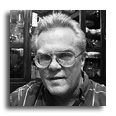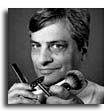
Neil

Obie
The love affair between the straight razor and the strop is like reading Jane Austen by a warm fire, or savoring port wine with Stilton cheese. For me, aside from tuning the blade as if a musical instrument, stropping paves a link into a state of bliss. I often find myself stropping far more than I need to just because of that. No wonder I continue to explore the world of strops and strop makers. One such world belongs to British strop maker Neil Miller, whose vast interests and talents have amounted to a string of successful careers.
Obie: As a maker of strops, how do you view the relationship between the straight razor and the strop?
Neil: Well, let's start by stating the obvious. You can't have one without the other. Seriously though, I like your “tuning the blade” analogy. I find that very apt. The relationship between the two is also synergistic in that the raw, freshly honed razor's edge is enhanced by stropping. Stropping also conditions the strop, burnishing its surface. For me the act is deeply symbolic, too. It provides a bridge between the past and the present, and represents continuity.
Obie: As a tuning instrument, then, what essential properties does a quality strop possess?
Neil: As long as the leather is of sufficient quality, has no artificial top layer, is suitably pliable for the type of strop and possesses suitable draw, then the prime requirements are met. Width and length come next in importance. Handles, hanging gear, swivels, hooks and means of attachment are all of secondary importance.
Obie: Going on the assumption of every positive having its parallel negative, what screams of a low quality strop that one should avoid?
Neil: Anything that does not meet at least the first four requirements should be regarded with a certain amount of caution. For instance, a hanging strop made with a hard, card-like leather that has no draw at all is next to useless. Unless it is designed to undergo a breaking-in regime. That is something rarely seen nowadays, but it was common with older strops. I mean particularly the old Russian-tanned strops — the name persists, but the strops are not the same these days.
The leather is of prime importance, providing it is of good quality — and the strop will be OK. Price is something of a determining factor, too, although a good, serviceable strop can be produced for quite a small sum. If the price looks too cheap, then it is in all probability not good for the purpose.
Obie: A subtle war has always existed between the hand-made and the machine-made worlds. Clothing, automobile seats, straight razors, strops, just about everything, I suppose — one or the other may win the battle, but who the war?
Neil: I don't think I would use the words “battle” and “war,” Obie. In a way we are comparing two different philosophies, both of which have their good points. Which one you choose, machine-made or hand-made, will most likely have more to do with your own philosophy of life than with one being inherently better than the other. As with most things in life there is no simple answer. One man might choose a megabuck custom made razor, another a more pedestrian model. If they both do the job to the particular individual's requirements, all is well and good.
Obie: In our correspondence you’ve made a statement that intrigues me. It’s a profound statement, I might add. You’ve said, “I like to see the hand of man in human works.”
Neil: That is part of my philosophy of life. I believe that mere mortals can aspire to perfection, but never attain it — that is the province of the gods. When I see something impressive made by a machine, I appreciate its value. But when I see something impressive that is hand-made by a man, I can see the heart and soul that has gone into it, and I am infinitely more impressed. The small tell-tale marks that something has been hand-made are like tracks in time, another link to the past when all things were hand made out of necessity.
Sometimes when I restore or repair vintage razors, I find the maker’s initials scratched on the inside of the scales. In recovering old paddle strops I have revealed handwriting on the timber that was covered with leather. In repairing old camera lenses I have seen the lens grinder's name signed in India ink on the outer rim of the brass-bound lens. These things have a visceral impact for me that is hard to put into words. It could include nostalgia, tradition, toil, remembrance, continuity, sentimentality, solidity — all these things and more.
Obie: So then I can only assume you lay open this philosophy before you like a book and proceed to use the recipe to make the Neil Miller strop. How does a strop start in your handcrafted world and the process of making it progress?
Neil: Not with a recipe, unfortunately. It starts with the leather, with a half or full hide, a croupon or a small oval shell. I have to feel the nap, if any, the natural grain, the scars and the marks. Then I can see the strop.
Obie: What determines what type of a strop you make, what style, and what size?
Neil: As I said, the leather kind of dictates its end use for the most part. Once that has been established I can see where I want to go. When I worked in design, we were taught to “feel what's in the air.” It’s a semi nonsensical phrase that means you are guided more by feeling or intuition than by anything else. Of course, that “intuition” is colored in great degree by what you have previously experienced, so it's probably not a blind thing anyway. Don't tell the fashion designers I said that, by the way.
Obie: Not a peep out of me. Tell me, does each type and size strop offer specific challenges or are they not all that different?
Neil: Width, thickness and tanning make a huge difference. For a 3-inch strop we ideally want leather that is not too prone to cup or to curl. Most leathers will exhibit this tendency to some degree. They were once the coverings of curvilinear animals, after all. So we have to choose carefully. Something from near the shoulder will not be that appropriate, for example, as the skin of the animal in life was quite bent and stretched in that location. The thickness will dictate how the handles and the hardware are applied. Very thick leathers, say around 5 millimeters, aren't that easy to sew, so you have to resort to rivets or to skiving it down where it is to be joined.
Hanging strops offer the most challenges. Paddles let you get over things like thickness and the tendency to cup or curl — the thinnest and thickest leathers may be used with freedom. Shorter lengths of leather are used, too, so something prone to much scarring can be used more effectively. For instance, kangaroos tend to be quite battle-scarred.
Obie: Do you find the need to match a certain type of leather, fabric or linen to a specific type of a strop? Or is it one for all?
Neil: Bearing in mind what we discussed, I think that apart from hanging strops, loom-type strops have a certain requirement that must be complied with. That is the use of a thicker, more compactly tanned leather. I have seen a lot of loom strops where the leather has been distorted and ended up permanently cupped or curled.
Obie: What type of leather do you fancy most?
Neil: I like shell cordovan, really, but I don't use it regularly. I strop so many razors every day that I could not justify the price. I go through quite a few strops. A good tallow tan leather is almost as good as shell, and the particular type of Latigo I use forms my everyday strop. It is thinner than normal, much finer grained and less oiled, possessing a medium-light draw.
Obie: What about the second part of the strop? Linen, fabric or felt?
Neil: Genuine linen every time. It has a slight edge over cotton/canvas, a bigger edge over felt, and is a delight to use.
Obie: I prefer a 2.5-inch strop, not too long, soft steer hide with a medium draw, and with genuine linen component. I like horse, too. Kangaroo I haven’t tried. As a maker of strops, do you find yourself leaning in any particular direction?
Neil: The 2.5-inches wide for me too, Obie. Latigo and linen. That serves for everyday use for my own razors. For razors I hone for others I use two different leathers. The first has a heavier draw — oiled English bridle — to bring the edge out. The second has a fast draw and refines the edge.
Obie: In your experience, what do shavers mostly demand? Now, I’m not all that fond of the 3-inch strop, especially since some have a tendency to buckle more than the 2.5-inch. Also, the X-pattern stropping comes naturally to me, so much so that even on my only 3-inch strop I still do the X-pattern. I have a feeling though that the 3-inch is probably the most popular.
Neil: You are right. Most people ask for a 3-inch wide one. The shell cordovan and the red lightly oiled English bridle seem to be favorites, too. However, a lot of these requests come from newbies who have just got their first open razor, so I try to discourage them out of buying an expensive strop and to learn on a cheap model until they have got the knack. I'm getting quite good at doing myself out of expensive orders.
Obie: The Universe has its own way of writing our script, and often the path in our life colors what we create and how we create it. That’s true with me in my writing, and was in the years I spent behind the radio microphone. You’ve had a colorful life, starting as a designer at London’s Chelsea School of Art. You’ve also run a light engineering factory, built houses, worked as a laborer building roads, had a stint as a photographer, and several other gigs. What has driven you through this varied career exhibition?
Neil: I have been very lucky, Obie. I didn't settle down until quite late in life, and although I earned good money in the past, money has never meant that much to me. It’s just as well, seeing as I don't earn much now. I have been just as happy being a student or digging holes in the road than as an executive director. Life has been like a meandering country road to me. There have always been other avenues to explore, different forks to take, and places to just stop, look and listen.
Obie: How has this background, then, influenced your creative work?
Neil: I suppose the chief thing is that I have never felt bound to do any one thing. My wife works, too, and this has been an enormous help. The things I choose to do all have some sort of thread going through them, even if it is very tenuous — or even conforming to Jung's Acausal Connecting Principal.
Obie: Which is a principal that centers, more or less, on a pattern of connection that can’t be explained conventionally. It’s all about coincidence — that some of the experiences we perceive as coincidence are not merely due to chance, but rather to the manifestation of parallel events and circumstances.
Neil: I feel that was the case with most of the things I did when I was younger. Less so now.
Obie: The love of working with your hands, fortunate for straight razor shavers, also has propelled you into strop making. Had you been shaving with the straight razor before you decided to make strops?
Neil: That's very kind of you to say so, thank you. I did own a microtome razor when I was 11 or so — not to shave with, though. I used it to prepare thin specimens for microscope slides. I couldn't afford the body of the microtome — nor the razor, to be honest — it was the result of a gift. So I had to make that myself, along with the strop.
Obie: What, then, led you to making strops?
Neil: When I got my first open razor, I had to have a strop, so I bought a very cheap one. Big mistake. It was hard and horrible, the hanging gear was a bent bar with a nail going through the middle, its end cut off and the shank formed into a loop. I still see them in use. If you look the head of the nail, it even has the check-marks on it. And the handle is a thin bit of stitched plastic-looking leather. I made my own strop and relegated the shop-bought one to having its ends cut-off, pasting it to a board, sanding it and coating it with chrome-oxide.
Obie: Your strops now are available through your own online shop.
Neil: That's right. Nowhere else. I have been approached by several large, well known re-sellers, but as all the strops are more or less unique and only made in small quantities, I couldn't meet the demand. Not that I want to, anyway. It's a creative process for me, something to take time over and make a personal investment in, not a mass-production money maker. If I had to produce them in large, regular quantities, all standardized to look the same, I'd fall out of love with it, I think.
Obie: What is it about leather that attracts you? You obviously have to love leather.
Neil: I like everything about it — the smell, the feel, its organic nature, its uniqueness. Plus it forms another one of those all-important links for me. It ties me into the past and brings the past into the present and hopefully the future.
Obie: What type of a strop, then, do you recommend for a newbie?
Neil: I can't emphasize enough that the leather is all important. It doesn't have to cost the earth. It just has to do the job effectively. Good leather, medium draw, at least 12 inches of clear stropping length and at least 2 inches in width. Slightly wider and a bit longer would be better. Paddles take the guess out of how taut to pull the strop, but you might as well bite the bullet and get a hanging strop. A paddle can always come in handy later as the carrier of an abrasive — they are more suited for this purpose than hanging strops. Get something cheap enough that you wont fret about when learning. You wouldn't take driving lessons in a Rolls Royce, would you?
Obie: What do you recommend for the strop’s care and maintenance?
Neil: I try to use leathers that do not need any significant amount of care other than hand-rubbing. Rather than try to adjust the draw by adding oil or tallow, I think it preferable to get leather with the required amount of draw right from the start.
Obie: What is your general stropping method and can you offer suggestions to the newbie as well as the pro?
Neil: I wouldn't presume to lecture to a pro. I guess we all form our own routines that suit us well enough, but which another would find fault with. With a linen/leather hanging strop there is a short adjustment period during which the leather gets burnished by the act of stropping, then settles down and changes very gradually thereafter. For a newbie, then, once this settling in period has taken place, there are just a few simple guidelines to follow. Laps on linen should be in the order of 20 to 40 followed by 40 to 60 on plain leather. Forget about oils, sharpening pastes and powders for the present. Say you go for 30 linen and 50 leather and get a good edge. You can then start by altering the ratios, possibly only one at a time, until you get an edge that is better and which you can repeat with the same regimen.
My own routines include linen/oiled buffalo/Latigo/dry buffalo in different configurations, driven mainly by the razor in use. It doesn't make much sense, I know, but certain of my razors respond differently to different leathers. I sometimes use a very glazed, fairly fast draw buffalo strop with graphite powder sprinkled and rubbed into it. Again, it is hard to see why it works as it does — by refining the edge to a finer degree than if the graphite had not been used — but it does. On the other hand, what exactly is going on during the process of stropping? I shall abandon this subject by just mentioning the words “plastic flow” and waiting for the furor to subside.
Obie: Sorry, Neil, but you have me curious. What do you mean by “plastic flow” in stropping?
Neil: It's a term used to help explain the deformation of a substance once a certain amount of force has been applied. In stropping it refers to what happens to the metal at the bevel. It is said to deform somewhat due to the act of stropping. It is based on a sound principal, but is of debatable importance in this instance.
Obie: A colorful ritual frames traditional shaving with the straight razor. We’re loaded with fallacies, too. What are some of the fallacies centered on strops, strop making and stropping?
Neil: The obvious things that spring to my mind are really more in the realm of the theoretical rather than fallacious. Microfins, not stropping after shaving so the edge can “rest,” plastic flow, the use of substances softer than steel, that is graphite, and so on — I would include them in this area.
The use of newsprint is not quite within this area. It borders on the magical, but it does work. I believe that the paper itself has a degree of abrasiveness, and that in the old days the greasy newsprint had a lead-graphite content that helped. Most newspapers are produced with water-jet technology these days I think, using dyes rather than pigments, so this shouldn't enhance the effect. That people say it does only adds to the wonderful “magic” of it all.
One thing you often hear people advocating is using your belt as a strop. I suppose there are belts and then there are belts. Generally speaking, belts are not strops, though.
One last thing that springs to mind is the almost obsessive need felt by some to oil a strop. Maybe as part of a yearly maintenance program it might be wise to do this with certain leathers, but for a new strop? You can always add oil, but it is very hard to take it away again.
Obie: Of course, as a man who loves working with his hands, you also restore straight razors. Let’s put it this way: is there anything you don’t do?
Neil: I think I'll take the Fifth Amendment on that one, Obie.
Obie: You’ve had a rich and creative life. When you reflect on the past, do you regret missed opportunities or are you satisfied you did everything you wanted to do?
Neil: It is hard not to get all “Sinatra” over this, but yes, I have been very happy with my lot. I have been very lucky to have a wonderful wife, a loving family and to have had so many opportunities. I know that full well. Of course, there are very many things I would have liked to have done, but, to be frank, one lifetime isn't nearly long enough.
Obie: Looking to the future, what is left to do for Neil Miller?
Neil: That country road still has a good few miles to meander along. Who knows where the next fork will lead to?













